Electrostatic Precipitator Design Optimization for the Removal of Aerosol and Airborne Viruses
Abstract
1. Introduction
2. Working Principles of the ESP
2.1. ESP Sterilization through Particle Collection
2.2. Sterilization by Electroporation
2.3. ESP’s Role in Preventing the Spread of Airborne Viruses
2.4. Factors Influencing the Dust Collection Efficiency of ESPs
2.5. Simulation of Particle Movement Trajectories
3. Experimental and Simulation Setup
3.1. Experimental Setup
3.1.1. JEMA Standard
3.1.2. Ozone Generation Standard
3.2. Simulation Setup
- Simulation base on Cartesian coordinates;
- Steady flow and electric fields;
- Time-dependent particle trajectory;
- No slip condition between the wall and the fluid;
- The ambient temperature remains at 298.15 K and the reference air pressure is 1 atm (1.01 × 105 pa).
- A review of studies on sterilization through ESPs suggested that:
- E. coli carries negative electric charges when it is spread by air [38];
3.2.1. Mathematical Model
- Electric field
- The law of conservation of charge is expressed as:
- The current continuity equation in an electric field is expressed as:
- The Poisson’s equation is used as the boundary condition to calculate the normal component of the electrostatic field at the ESP electrode. The boundary condition formula is given as:
- The electric field at the discharge electrode is calculated using Peek’s law, which is expressed as:
- 2.
- Flow field
- Continuity Equation
- Momentum Equation
- Energy Equation
- The Reynolds number () is used to determine the laminar or turbulent flow for the air purifier tested, and it is defined as follows:
- The Reynolds number ranged from 5512 to 7438. This suggested that the ESP flow in this study was turbulent. The compressibility of the fluid can be determined by the Mach number (M), which is calculated using the following formula:
- 3.
- Particle tracking in the flow field
- •
- Particle motion in the flow field follows Newton’s second law, and the particle positions are determined using a second-order equation for vector components, as expressed by the following formula:
- The motion of particles in the flow field is influenced by drag force, electric field force, and the interaction between particles and the fluid, which can be calculated based on particle mass, density, and diameter. The equation for the particle trajectory is expressed as follows:
- When the fluid medium is continuous, incompressible, and viscous, Stokes’ Law can be used to represent the drag force generated by particles in the fluid motion or the force exerted by the fluid on stationary particles. Under low-Reynolds-number conditions, if the particle velocity is greater than the fluid velocity, the drag force on the particle increases, and the rarefaction effects must be considered for small particle radii. The drag force is expressed as follows:
- The electric force () acting on particles is related to the charge accumulated on the particles. The formula is expressed as follows:
3.2.2. Boundary Conditions
3.3. Design Optimization
3.3.1. Multi-Objective Genetic Algorithm (MOGA)
3.3.2. Multi-Objective Function and Constraints
4. Results and Discussions
4.1. Standard Test Results
4.2. Validating Experimental and Simulation Results
4.3. ESP Optimization Results
- When the particle size was 0.1μm–5.0 μm and the flow speed increased from 1.46 m/s to 1.94 m/s, the ESP’s average collection efficiency decreased by 12.7% at a voltage of 5 kV and 4.1% at 6.5 kV.
- When the particle size was 0.1μm–5.0 μm and the voltage in the ESP increased from 5 kV to 6.5 kV, the ESP’s average collection efficiency increased by 2.7% at a flow speed of 1.46 m/s and 11.3% at 1.94 m/s.
- When the particle size increased from 0.1 μm to 0.3 μm at a uniform flow speed and a 5 kV voltage, the ESP’s collection efficiency decreased by 7.8% at a flow speed of 1.46 m/s and 30.2% at 1.94 m/s.
- When the particle size increased from 0.3 μm to 5.0 μm at a uniform flow speed and a 5 kV voltage, the ESP’s collection efficiency increased by 10.6% at a flow speed of 1.46 m/s and 32.1% at 1.94 m/s.
- When the particle size increased from 0.1 μm to 0.3 μm at a uniform flow speed and a 6.5 kV voltage, the ESP’s collection efficiency decreased by 0.9% at a flow speed of 1.46 m/s and 17.4% at 1.94 m/s.
- When the particle size increased from 0.3 μm to 5.0 μm at a uniform flow speed and a 6.5 kV voltage, the ESP’s collection efficiency increased by 3.4% at a flow speed of 1.46 m/s and by 19.7% at 1.94 m/s.
5. Conclusions and Future Directions of Research
Author Contributions
Funding
Institutional Review Board Statement
Data Availability Statement
Acknowledgments
Conflicts of Interest
Nomenclature
| Cross-sectional area | |
| Drag Coefficient | |
| Empirical Constant | |
| D | hydraulic diameter of the pipe (m), |
| Particle Diameter (m) | |
| Electric Field Strength | |
| Electric Field of the Electrode | |
| Critical Breakdown Electric Field (V/m) | |
| Elementary Charge of an Electron | |
| Drag Force Acting on the Particle | |
| Electric Field Force Acting on the Particle | |
| Force Acting on the Particle | |
| Current Density | |
| Characteristic Length | |
| M | Mach Number |
| Particle Mass | |
| Q | Volumetric Flow Rate |
| q | Particle Position |
| Reynolds Number | |
| Relative Reynolds Number | |
| Electrode Radius (m) | |
| S | Resistance Correction Coefficient |
| T | Temperature (K) |
| t | Time (s) |
| g | Gravity |
| p | Pressure (Pa) |
| u | Flow Velocity |
| Velocity | |
| Particle Velocity | |
| V | Electric Potential (V) |
| Z | Net Charge on a Single Particle |
| Charge Number | |
| Air Density (kg/m3) | |
| Molecular Conductivity | |
| Turbulent Conductivity | |
| Vacuum Permittivity | |
| Dynamic Viscosity of Fluid | |
| Ion Mobility | |
| Turbulent Dynamic Viscosity | |
| Density of Fluid | |
| Particle Density | |
| Space Charge Density | |
| Kinematic Viscosity | |
| Particle Relaxation Time |
References
- World Health Organization Europe (WHO Europe). Transmission of SARS-CoV-2: Implications for Infection Prevention Precautions; Scientific Brief; WHO: Geneva, Switzerland, 2020. [Google Scholar]
- Centers for Disease Control and Prevention USA How COVID-19 Spreads. Available online: https://www.cdc.gov/socialmedia/syndication/405380/403327.html (accessed on 18 July 2022).
- De, F.; Lima, A.; Medeiros, G.B.; Augusto, P.; Chagas, M.; Lopes Aguiar, M.; Guerra, V.G. Aerosol Nanoparticle Control by Electrostatic Precipitation and Filtration Processes—A Review. Powders 2023, 2, 259–298. [Google Scholar] [CrossRef]
- Pushpawela, B.; Jayaratne, R.; Nguy, A.; Morawska, L. Efficiency of Ionizers in Removing Airborne Particles in Indoor Environments. J. Electrostat. 2017, 90, 79–84. [Google Scholar] [CrossRef]
- Othman, M.; Latif, M.T.; Yee, C.Z.; Norshariffudin, L.K.; Azhari, A.; Halim, N.D.A.; Alias, A.; Sofwan, N.M.; Hamid, H.H.A.; Matsumi, Y. PM2.5 and Ozone in Office Environments and Their Potential Impact on Human Health. Ecotoxicol. Environ. Saf. 2020, 194, 110432. [Google Scholar] [CrossRef] [PubMed]
- Xiong, W.; Lin, Z.; Zhang, W.; Chen, T.; Zhao, C. Experimental and Simulation Studies on Dust Loading Performance of a Novel Electrostatic Precipitator with Dielectric Barrier Electrodes. Build. Environ. 2018, 144, 119–128. [Google Scholar] [CrossRef]
- Liu, S.; Huang, Q.; Zhang, X.; Dong, W.; Zhang, W.; Wu, S.; Yang, D.; Nan, B.; Zhang, J.; Shen, H.; et al. Cardiorespiratory Effects of Indoor Ozone Exposure Associated with Changes in Metabolic Profiles among Children: A Repeated-Measure Panel Study. Innovation 2021, 2, 100087. [Google Scholar] [CrossRef] [PubMed]
- Chen, L.; Gonze, E.; Ondarts, M.; Outin, J.; Gonthier, Y. Electrostatic Precipitator for Fine and Ultrafine Particle Removal from Indoor Air Environments. Sep. Purif. Technol. 2020, 247, 116964. [Google Scholar] [CrossRef]
- Arif, S.; Branken, D.J.; Everson, R.C.; Neomagus, H.W.J.P.; le Grange, L.A.; Arif, A. CFD Modeling of Particle Charging and Collection in Electrostatic Precipitators. J. Electrostat. 2016, 84, 10–22. [Google Scholar] [CrossRef]
- Zhu, J.; Zhao, Q.; Yao, Y.; Luo, S.; Guo, X.; Zhang, X.; Zeng, Y.; Yan, K. Effects of High-Voltage Power Sources on Fine Particle Collection Efficiency with an Industrial Electrostatic Precipitator. J. Electrostat. 2012, 70, 285–291. [Google Scholar] [CrossRef]
- Thonglek, N.; Dechthummarong, C.; Kiatsiriroat, T. Soot Treatment by Using High Voltage Pulse Energized Electrostatic Precipitator. Energy Procedia 2011, 9, 292–298. [Google Scholar] [CrossRef]
- Pal, A.; Dixit, A.; Srivastava, A.K. Design and Optimization of the Shape of Electrostatic Precipitator System. Mater. Today Proc. 2021, 47, 3871–3876. [Google Scholar] [CrossRef]
- Kim, H.J.; Han, B.; Kim, Y.J.; Yoa, S.J. Characteristics of an Electrostatic Precipitator for Submicron Particles Using Non-Metallic Electrodes and Collection Plates. J. Aerosol Sci. 2010, 41, 987–997. [Google Scholar] [CrossRef]
- Masuda, S.; Hosokawa, S. Performance of Two-Stage Type Electrostatic Precipitators. IEEE Trans. Ind. Appl. 1984, IA-20, 709–717. [Google Scholar] [CrossRef]
- Sjoholm, P.; Ingham, D.B.; Lehtimaki, M.; Perttu-Roiha, L.; Goodfellow, H.; Torvela, H. Gas-Cleaning Technology. In Industrial Ventilation Design Guidebook; Academic editor: Cambridge, MA, USA, 2001. [Google Scholar]
- Li, L.; Gopalakrishnan, R. An Experimentally Validated Model of Diffusion Charging of Arbitrary Shaped Aerosol Particles. J. Aerosol Sci. 2021, 151, 105678. [Google Scholar] [CrossRef]
- Ning, Z.; Sillanpää, M.; Pakbin, P.; Sioutas, C. Field Evaluation of a New Particle Concentrator- Electrostatic Precipitator System for Measuring Chemical and Toxicological Properties of Particulate Matter. Part. Fibre Toxicol. 2008, 5, 15. [Google Scholar] [CrossRef] [PubMed]
- Pirhadi, M.; Mousavi, A.; Sioutas, C. Evaluation of a High Flow Rate Electrostatic Precipitator (ESP) as a Particulate Matter (PM) Collector for Toxicity Studies. Sci. Total Environ. 2020, 739, 140060. [Google Scholar] [CrossRef]
- Zhu, Y.; Chen, C.; Chen, M.; Shi, J.; Shangguan, W. Numerical Simulation of Electrostatic Field and Its Influence on Submicron Particle Charging in Small-Sized Charger for Consideration of Voltage Polarity. Powder Technol. 2021, 380, 183–198. [Google Scholar] [CrossRef]
- Taiwan Centers for Disease Control. EM Atlas of Clinical Microbes; Centers for Disease Control, Department of Health: Taipei, Taiwan, 2009. [Google Scholar]
- Zimmermann, U.; Vienken, J.; Pilwat, G. Development of Drug Carrier Systems: Electrical Field Induced Effects in Cell Membranes. Bioelectrochem. Bioenerg. 1980, 7, 553–574. [Google Scholar] [CrossRef]
- Kotnik, T.; Kramar, P.; Pucihar, G.; Miklavčič, D.; Tarek, M. Cell Membrane Electroporation—Part 1: The Phenomenon. IEEE Electr. Insul. Mag. 2012, 28, 14–23. [Google Scholar] [CrossRef]
- Kotnik, T.; Bobanović, F.; Miklavčič, D. Sensitivity of Transmembrane Voltage Induced by Applied Electric Fields—A Theoretical Analysis. Bioelectrochem. Bioenerg. 1997, 43, 285–291. [Google Scholar] [CrossRef]
- Nunayon, S.S.; Zhang, H.H.; Jin, X.; Lai, A.C. Experimental Evaluation of Positive and Negative Air Ions Disinfection Efficacy under Different Ventilation Duct Conditions. Build. Environ. 2019, 158, 295–301. [Google Scholar] [CrossRef]
- Afshari, A.; Ekberg, L.; Forejt, L.; Mo, J.; Rahimi, S.; Siegel, J.; Chen, W.; Wargocki, P.; Zurami, S.; Zhang, J. Electrostatic Precipitators as an Indoor Air Cleaner—A Literature Review. Sustainability 2020, 12, 8774. [Google Scholar] [CrossRef]
- Long, Z.; Yao, Q. Evaluation of Various Particle Charging Models for Simulating Particle Dynamics in Electrostatic Precipitators. J. Aerosol Sci. 2010, 41, 702–718. [Google Scholar] [CrossRef]
- Lawless, P.A. Particle Charging Bounds, Symmetry Relations, and an Analytic Charging Rate Model for the Continuum Regime. J. Aerosol Sci. 1996, 27, 191–215. [Google Scholar] [CrossRef]
- Farnoosh, N.; Adamiak, K.; Castle, G.S.P. 3-D Numerical Analysis of EHD Turbulent Flow and Mono-Disperse Charged Particle Transport and Collection in a Wire-Plate ESP. J. Electrostat. 2010, 68, 513–522. [Google Scholar] [CrossRef]
- Kasdi, A. Computation and Measurement of Corona Current Density and V–I Characteristics in Wires-to-Plates Electrostatic Precipitator. J. Electrostat. 2016, 81, 1–8. [Google Scholar] [CrossRef]
- Zhang, J.; Chen, D.; Zha, Z. Theoretical and Experimental Study of Trapping PM2.5 Particles via Magnetic Confinement Effect in a Multi-Electric Field ESP. Powder Technol. 2020, 368, 70–79. [Google Scholar] [CrossRef]
- Ito, K.; Tamura, R.; Zukeran, A.; Kawada, Y.; Taoka, T. Simulation and Measurement of Charged Particle Trajectory with Ionic Flow in a Wire-to-Plate Type Electrostatic Precipitator. J. Electrostat. 2020, 107, 103488. [Google Scholar] [CrossRef]
- Clack, H.L. Further Consideration of Gas-Particle Mass Transfer Simulation during Electrostatic Precipitation Using Lower Order Representations of Particle Size Distributions: Variable Size Distributions. J. Electrostat. 2020, 104, 103418. [Google Scholar] [CrossRef]
- Zhou, W.; Jiang, R.; Sun, Y.; Chen, B.; Liu, B. Study on Multi-Physical Field Characteristics of Electrostatic Precipitator with Different Collecting Electrodes. Powder Technol. 2021, 381, 412–420. [Google Scholar] [CrossRef]
- Kılıç, M.; Mutlu, M.; Altun, A.F. Numerical Simulation and Analytical Evaluation of the Collection Efficiency of the Particles in a Gas by the Wire-Plate Electrostatic Precipitators. Appl. Sci. 2022, 12, 6401. [Google Scholar] [CrossRef]
- Fattah, R.; Reverberi, A.; Badran, M.; Mansour, A.M. Evaluating Performance Indices of Electrostatic Precipitators. Energies 2022, 15, 6647. [Google Scholar] [CrossRef]
- JEMA. JEM 1467: Household Air Purifiers; Japan Electrical Manufacturers Association (JEMA): Tokyo, Japan, 2015. [Google Scholar]
- Bureau of Standards, Metrology and Inspection, M.O.E.A. Household and Similar Electrical Appliances—Safety—Part2-65: Particular Requirements for Air-Clearning Appliances; Bureau of Standards, Metrology and Inspection, M.O.E.A.: Taipei, Taiwan, 2015; pp. 8–9. [Google Scholar]
- Simon, X.; Bau, S.; Bémer, D.; Duquenne, P. Measurement of Electrical Charges Carried by Airborne Bacteria Laboratory-Generated Using a Single-Pass Bubbling Aerosolizer. Particuology 2015, 18, 179–185. [Google Scholar] [CrossRef]
- Vega-Mercado, H.; Martín-Belloso, O.; Qin, B.L.; Chang, F.J.; Góngora-Nieto, M.M.; Barbosa-Cánovas, G.V.; Swanson, B.G. Non-Thermal Food Preservation: Pulsed Electric Fields. Trends Food Sci. Technol. 1997, 8, 151–157. [Google Scholar] [CrossRef]
- World Health Organization. Ambient Air Pollution; WHO: Geneva, Switzerland, 2018. [Google Scholar]
- Cao, Y.; Shao, L.; Jones, T.; Oliveira, M.L.S.; Ge, S.; Feng, X.; Silva, L.F.O.; BéruBé, K. Multiple Relationships between Aerosol and COVID-19: A Framework for Global Studies. Gondwana Res. 2021, 93, 243–251. [Google Scholar] [CrossRef]
- Hwang, S.E.; Chang, J.H.; Oh, B.; Heo, J. Possible Aerosol Transmission of COVID-19 Associated with an Outbreak in an Apartment in Seoul, South Korea, 2020. Int. J. Infect. Dis. 2021, 104, 73–76. [Google Scholar] [CrossRef]
- Deb, K.; Pratap, A.; Agarwal, S.; Meyarivan, T. A Fast and Elitist Multiobjective Genetic Algorithm: NSGA-II. IEEE Trans. Evol. Comput. 2002, 6, 182–197. [Google Scholar] [CrossRef]
- Chen, W.H.; Wang, C.M.; Lee, D.S.; Kwon, E.E.; Ashokkumar, V.; Culaba, A.B. Optimization Design by Evolutionary Computation for Minimizing Thermal Stress of a Thermoelectric Generator with Varied Numbers of Square Pin Fins. Appl. Energy 2022, 314, 118995. [Google Scholar] [CrossRef]
- Elsoragaby, S.; Yahya, A.; Mahadi, M.R.; Nawi, N.M.; Mairghany, M.; Elhassan, S.M.M.; Kheiralla, A.F. Applying Multi-Objective Genetic Algorithm (MOGA) to Optimize the Energy Inputs and Greenhouse Gas Emissions (GHG) in Wetland Rice Production. Energy Rep. 2020, 6, 2988–2998. [Google Scholar] [CrossRef]
- Pu, L.; Qi, D.; Xu, L.; Li, Y. Optimization on the Performance of Ground Heat Exchangers for GSHP Using Kriging Model Based on MOGA. Appl. Therm. Eng. 2017, 118, 480–489. [Google Scholar] [CrossRef]
- Quakernaat, J. Handbook of Electrostatic Processes. J. Clean. Prod. 1995, 3, 175. [Google Scholar] [CrossRef]
- Japan Air Cleaning Association. JP-G12_Dust Collection & Efficiency Ozone Measurement Test Report; Doc no, KU28-182; Japan Air Cleaning Association: Tokyo, Japan, 2016. [Google Scholar]
- Environmental Protection Administration. Indoor Air Quality Standard; Environmental Protection Administration: Taipei, Taiwan, 2012. [Google Scholar]
- Lei, H.; Wang, L.Z.; Wu, Z.N. EHD Turbulent Flow and Monte-Carlo Simulation for Particle Charging and Tracing in a Wire-Plate Electrostatic Precipitator. J. Electrostat. 2008, 66, 130–141. [Google Scholar] [CrossRef]

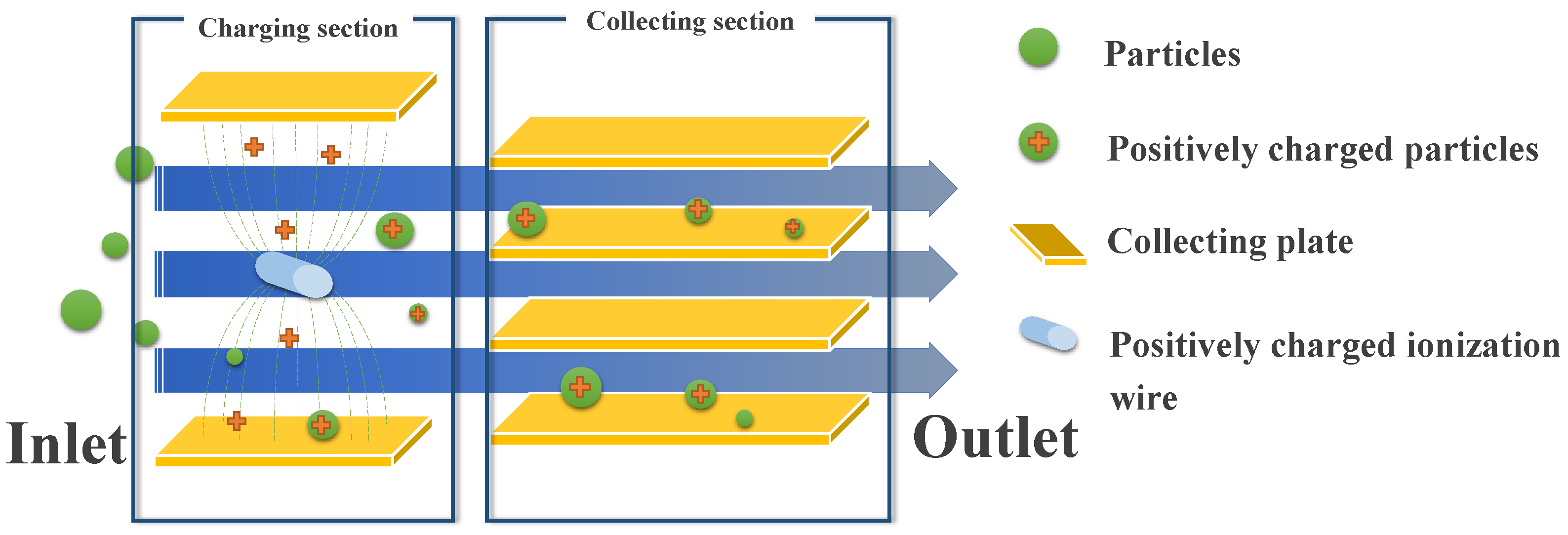
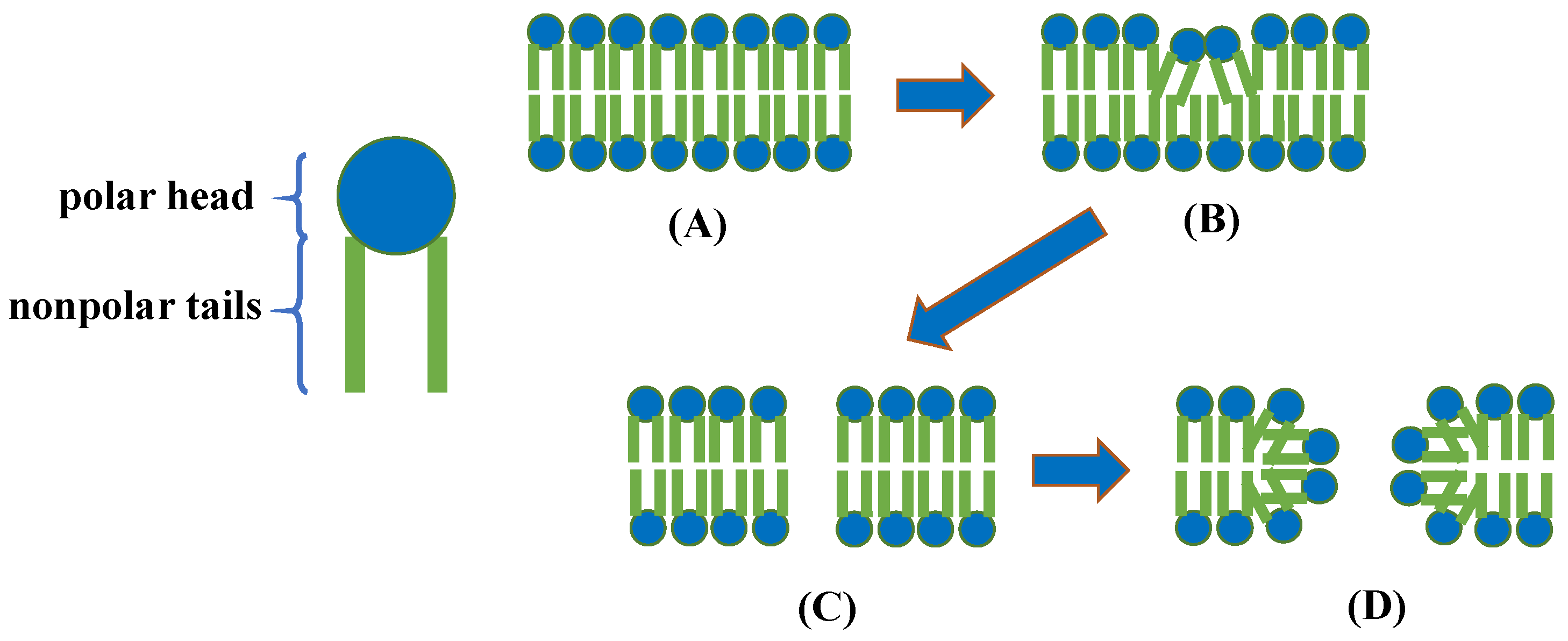

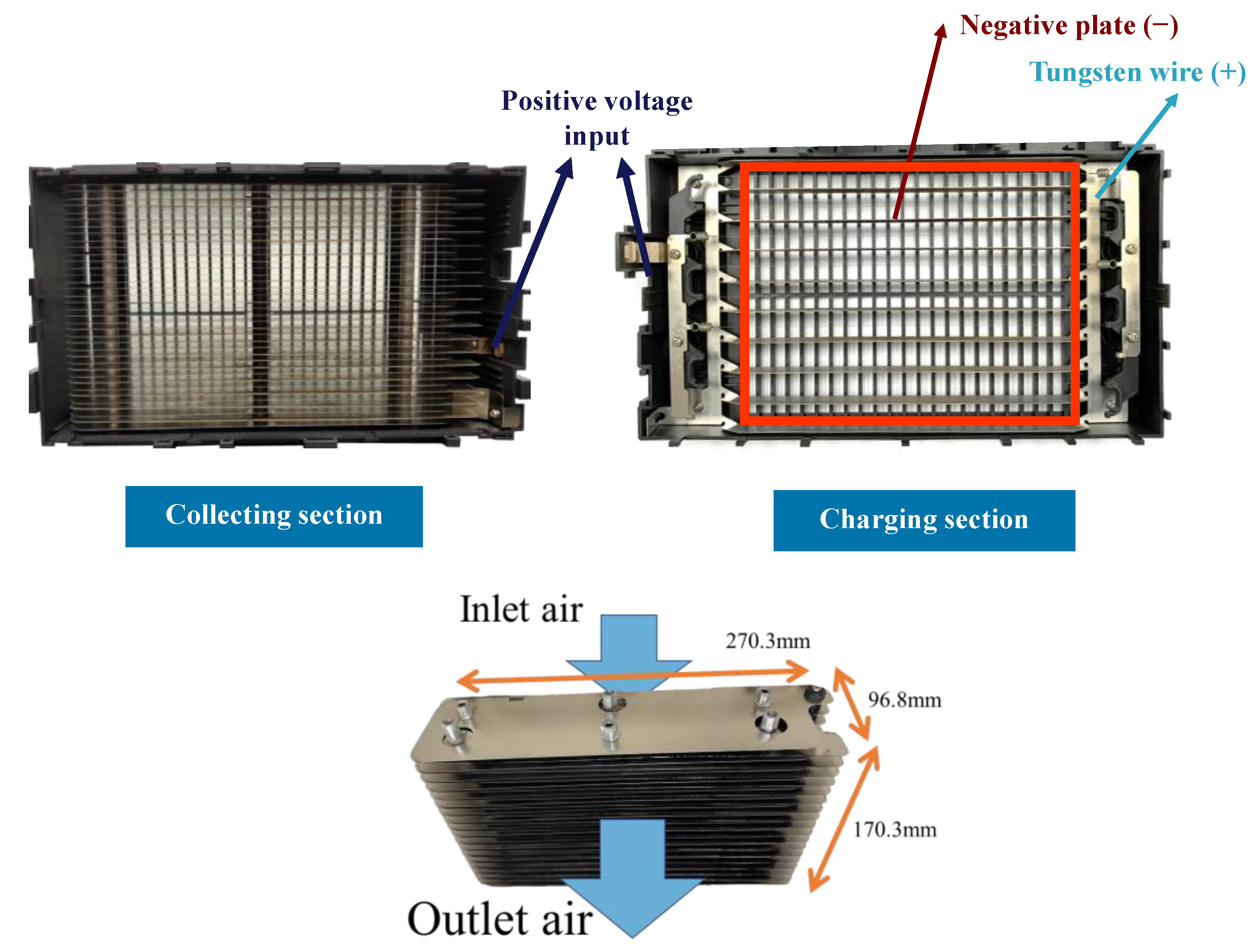




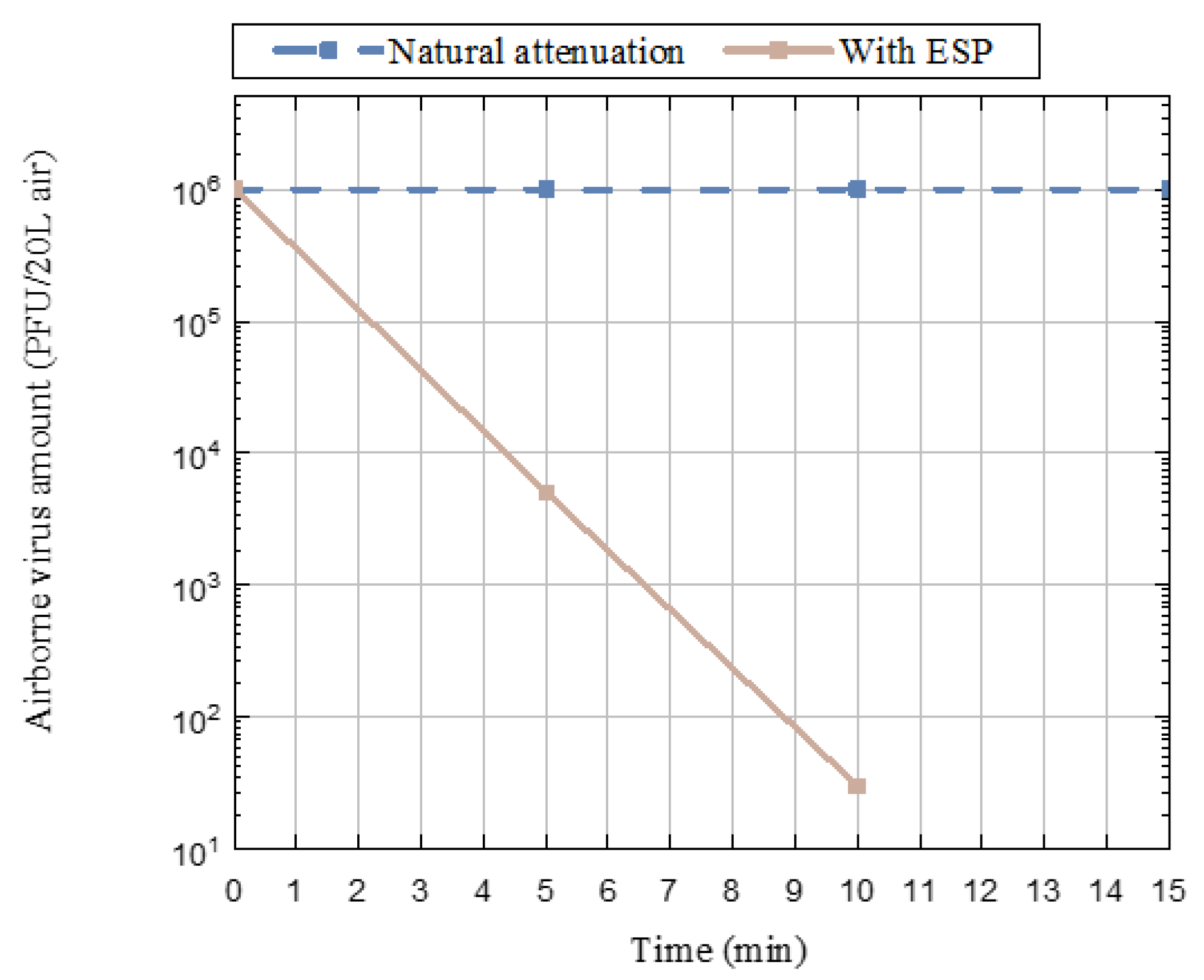
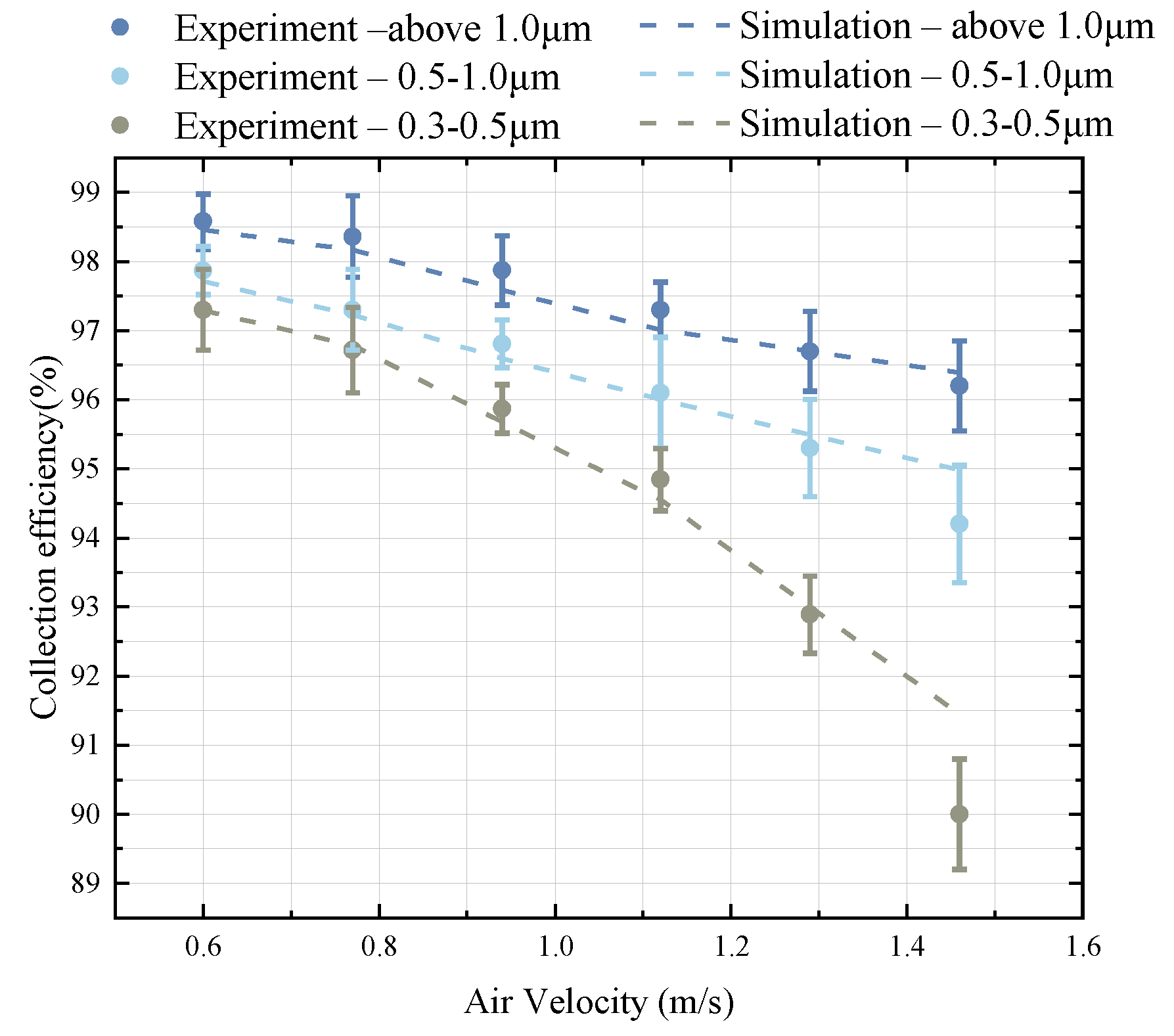
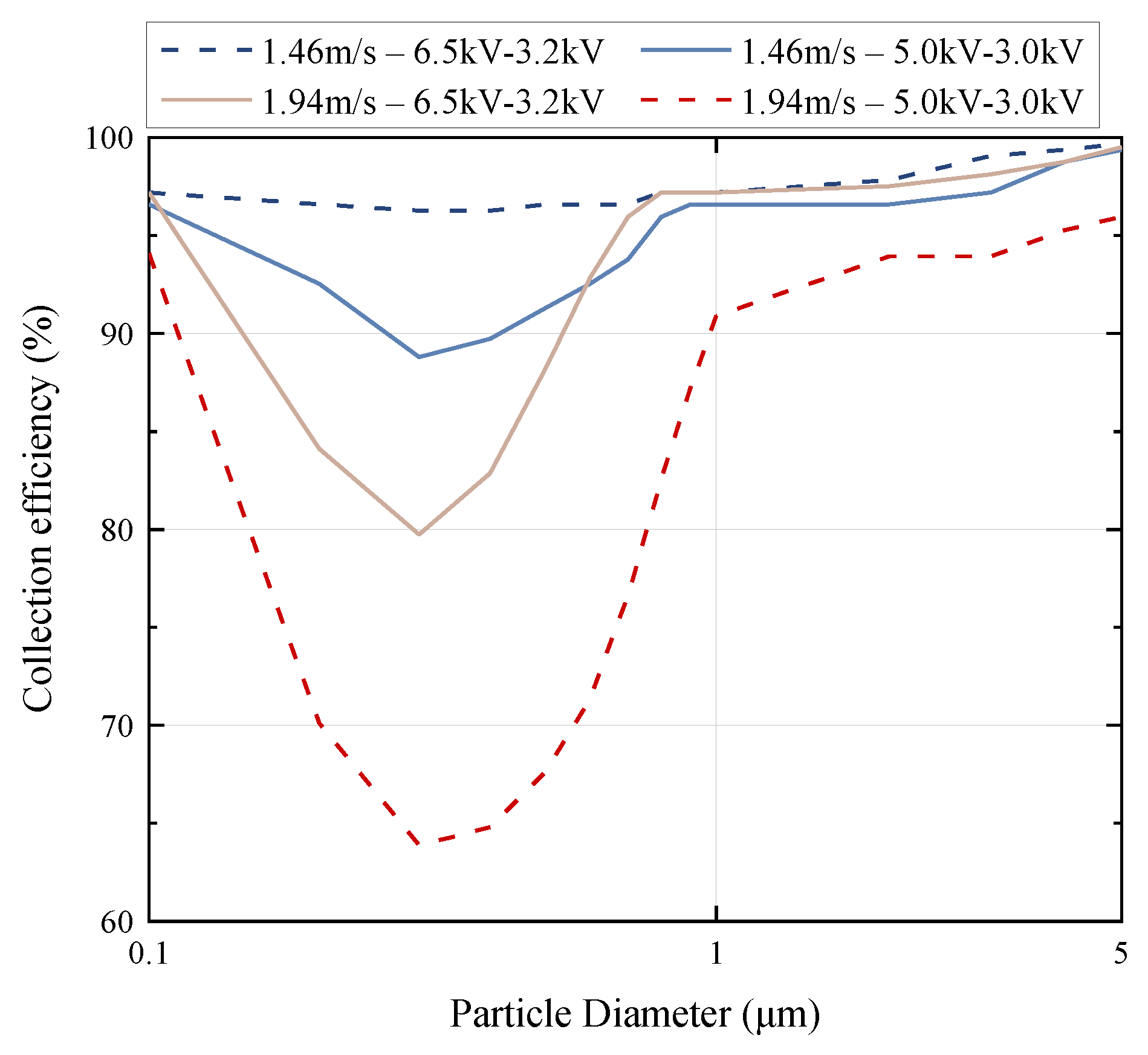

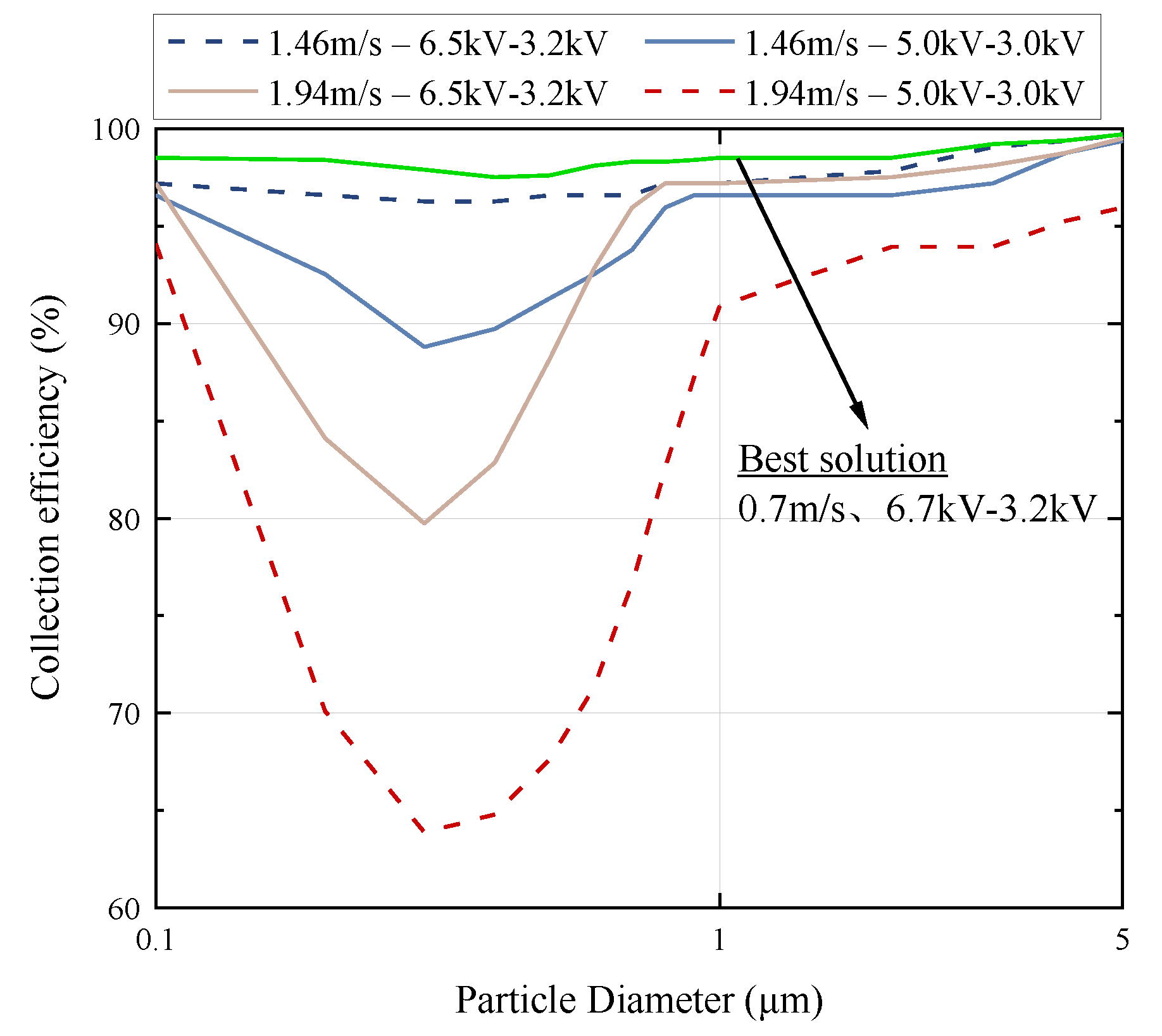
| Type | Viruses | |||
|---|---|---|---|---|
| Name | Coronavirus | Human metapneumovirus | Influenza B virus | Influenza A Virus (H1N1, 3N2) |
| Characteristics | 80–160 nm, enveloped | 156–300 nm, enveloped | 80–120 nm, enveloped, has a polymorphic appearance and appears in a spherical or tubular shape | 3.0–20 μm. |
| Causes mild upper respiratory tract infections or severe acute respiratory syndrome (SARS). | Causes upper and lower respiratory tract infections and cold symptoms. Children and older adults with weaker immunity are liable to pneumonia or other severe illnesses if infected. | Spreads fast by air. People with weak immunity are liable to pneumonia or other severe illnesses if infected. | Transmitted by droplets. | |
| Positive single-strand RNA virus | Negative single-strand RNA virus | Covers the nucleoprotein and transcriptases of the RNA | ||
| Type | Bacterium | |||
|---|---|---|---|---|
| Name | Bordetella pertussis | Staphylococcus aureus | Escherichia coli (E. coli) | Legionella pneumophila |
| Characteristics | 0.1–0.5 μm in diameter, 0.5–2.0 μm in length, Brevibacteria, has a bacterial capsule | 0.5–1.0 μm in diameter | 1.5–3.0 μm in diameter | 2.0.–5.0 μm in diameter, has no bacterial capsule |
| A bacterial respiratory tract disease that has humans as the only host and spreads by air or droplets. | A hospital-acquired bacterium with an aerodynamic diameter of 0.7–0.8 μm. | Spreads by water have an aerodynamic diameter of 0.78 μm. | Causes Legionnaires’ disease, leading to inflammation in the lungs. | |
| Name | Neisseria meningitidis | Pseudomonas aeruginosa | Streptococcus pneumoniae | Mycobacterium tuberculosis |
| Characteristics | 0.5–1.0 μm, has no bacterial capsule, spherical | 0.5–1.0 μm in diameter and 2.0–5.0 μm in length, has no endospore and has one flagellum. | 0.4–1.2 μm in diameter, has a bacterial capsule | 0.2–0.6 μm in diameter and 1–10 μm in length, has a shape resembling a short spherical rod or long chain. |
| Spreads by droplets | Grown in moist environments, spreads by different media. | Spreads by air, droplets, dust, or by droplet nuclei. | ||
| Article | 2016, Kasdi [29] | 2018, Xiong et al. [6] | 2020, Ito [31] | 2020, Clack [32] | 2021, Zhou et al. [33] |
|---|---|---|---|---|---|
| Dimensions | 2D | 2D | 2D | 2D | 2D |
| Number of ionization lines | 1–5 | 90 | 1–10 | 3 | 3 |
| Ionization line diameter | 0.4, 0.8 | 2 | 0.26 | 1 | 2 |
| Distance between ionization lines | 40, 60, 80 | 50 | 15 | 500 | 200 |
| Length of dust collection plate | 0.77 | 0.51 | 0.05 | 2 | 0.6 |
| Distance between dust collection plates | 0.1 | 0.04 | 0.03 | 0.3 | 0.2 |
| Type of electrostatic dust collection | 1 step | 2 steps | 1 step | 1 step | 1 step |
| Fluid flow module | - | turbulent (spf) | turbulent (spf) | turbulent (spf) | turbulent (spf) |
| Flow field | - | (Low Re) | - | ||
| Flow velocity | - | 1.0, 2.5 | 1 | 0.75, 1.55, 3 | 0.1 |
| Electric field module | - | static electricity (es) | - | static electricity (es) | static electricity (es) |
| Electrode electric field | Peek’s law | - | - | - | Peek’s law |
| Static | Poisson’s equation | - | Poisson’s equation | Poisson’s equation | Poisson’s equation |
| Current continuity equation | - | Current continuity equation | Current continuity equation | Current continuity equation | |
| Particle trajectory | - | Kuhn-Han correction factor | - | Kuhn-Han correction factor | - |
| - | - | - | Lagrangian function | Lagrangian function | |
| - | Newton’s Second Law | Newton’s Second Law | - | Newton’s Second Law | |
| Charging mechanism | - | Cochet, 1961 | - | Electric Field Charging | Lawless, 1996 |
| Mesh element | - | - | 1,300,000 | 25,000 | 10,000–27,000 |
| Ion migration rate (m2/Vs) | 0.00018 | 0.00021 | 0.000169 | - | 0.00016 |
| Parameter | JEMA Experiment |
|---|---|
| Flow speed | 1.94 |
| Voltage of the ionization wire | 6.5 |
| Voltage of positively charged collecting plates | 3.2 |
| Bacteria | E. coli bacteriophages, Influenza A virus (H1N1) |
| Particle size (μm) | 0.02–0.2 |
| Gas Flow Velocity | Gas Temperature | Gas Pressure | Gas Density | Gas Viscosity Coefficient | Gas Dielectric Constant |
|---|---|---|---|---|---|
| 0.5–1.95 | 298.15 | 101,325 | 1.184 | 1 [29,30] | |
| Positive Electrode Dust Collecting Plate Voltage | Positive Electrode Dust Collecting Plate Voltage () | Particle Diameter () | Particle Density | Particle Viscosity Coefficient | Particle Dielectric Constant |
| 5.0, 6.5 | 3.0, 3.2 | 0.3–1.2 | 3900 [33] | 2.5 [9,26] |
| Ultraviolet Absorption Ozone Concentration Meter: 1006AHJ | ||||
|---|---|---|---|---|
| Wind volume: | Ozone concentration | Amount of ozone generated: | ||
| Upstream: | Downstream: | Difference | ||
| 2.0 | 0.0004 | 0.0142 | 2.0 | 0.0004 |
Disclaimer/Publisher’s Note: The statements, opinions and data contained in all publications are solely those of the individual author(s) and contributor(s) and not of MDPI and/or the editor(s). MDPI and/or the editor(s) disclaim responsibility for any injury to people or property resulting from any ideas, methods, instructions or products referred to in the content. |
© 2023 by the authors. Licensee MDPI, Basel, Switzerland. This article is an open access article distributed under the terms and conditions of the Creative Commons Attribution (CC BY) license (https://creativecommons.org/licenses/by/4.0/).
Share and Cite
Chen, Y.-T.; Lu, C.-L.; Lu, S.-J.; Lee, D.-S. Electrostatic Precipitator Design Optimization for the Removal of Aerosol and Airborne Viruses. Sustainability 2023, 15, 8432. https://doi.org/10.3390/su15108432
Chen Y-T, Lu C-L, Lu S-J, Lee D-S. Electrostatic Precipitator Design Optimization for the Removal of Aerosol and Airborne Viruses. Sustainability. 2023; 15(10):8432. https://doi.org/10.3390/su15108432
Chicago/Turabian StyleChen, Yen-Tang, Cheng-Lung Lu, Shang-Jung Lu, and Da-Sheng Lee. 2023. "Electrostatic Precipitator Design Optimization for the Removal of Aerosol and Airborne Viruses" Sustainability 15, no. 10: 8432. https://doi.org/10.3390/su15108432
APA StyleChen, Y.-T., Lu, C.-L., Lu, S.-J., & Lee, D.-S. (2023). Electrostatic Precipitator Design Optimization for the Removal of Aerosol and Airborne Viruses. Sustainability, 15(10), 8432. https://doi.org/10.3390/su15108432







